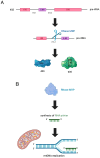Anti-Th/To Antibodies in Scleroderma: Good Prognosis or Serious Concern?
- PMID: 38892733
- PMCID: PMC11172938
- DOI: 10.3390/jcm13113022
Anti-Th/To Antibodies in Scleroderma: Good Prognosis or Serious Concern?
Abstract
Systemic sclerosis (SSc) represents a rare and intricate autoimmune connective tissue disease, the pathophysiology of which has not been fully understood. Its key features include progressive fibrosis of the skin and internal organs, vasculopathy and aberrant immune activation. While various anti-nuclear antibodies can serve as biomarkers for the classification and prognosis of SSc, their direct role in organ dysfunction remains unclear. Anti-Th/To antibodies are present in approximately 5% of SSc patients, and are particularly prevalent among those with the limited subtype of the disease. Although the presence of these autoantibodies is associated with a mild course of the disease, there is a strong connection between them and severe clinical manifestations of SSc, including interstitial lung disease, pulmonary arterial hypertension and gastrointestinal involvement. Also, the additional clinical correlations, particularly with malignancies, need further research. Moreover, the disease's course seems to be influenced by antibodies, specific serum cytokines and TLR signaling pathways. Understanding the relationships between presence of anti-Th/To, its molecular aspects and response to treatment options is crucial for the development of novel, personalized therapeutic techniques and should undergo profound analysis in future studies.
Keywords: RNAse MRP and P; anti-Th/To; autoantibodies; interstitial lung disease; pulmonary arterial hypertension; scleroderma; systemic sclerosis.
Conflict of interest statement
The authors declare no conflicts of interest.
Figures




Similar articles
-
Systemic Sclerosis-Specific Antibodies: Novel and Classical Biomarkers.Clin Rev Allergy Immunol. 2023 Jun;64(3):412-430. doi: 10.1007/s12016-022-08946-w. Epub 2022 Jun 18. Clin Rev Allergy Immunol. 2023. PMID: 35716254 Free PMC article.
-
Joint contractures responsive to immunosuppressive therapy in a girl with childhood-onset systemic sclerosis double-seropositive for rare anti-nucleolar autoantibodies: a case report.Pediatr Rheumatol Online J. 2021 Mar 20;19(1):37. doi: 10.1186/s12969-021-00525-1. Pediatr Rheumatol Online J. 2021. PMID: 33743728 Free PMC article.
-
Pulmonary manifestations and prognosis of a cohort of patients with interstitial lung disease and positive to anti-Th/To autoantibodies.Med Clin (Barc). 2024 Apr 26;162(8):378-384. doi: 10.1016/j.medcli.2023.11.023. Epub 2024 Jan 29. Med Clin (Barc). 2024. PMID: 38290874 English, Spanish.
-
Autoantibody profiles in systemic sclerosis: predictive value for clinical evaluation and prognosis.J Dermatol. 2010 Jan;37(1):42-53. doi: 10.1111/j.1346-8138.2009.00762.x. J Dermatol. 2010. PMID: 20175839 Review.
-
Autoantibodies in systemic sclerosis (scleroderma): clues for clinical evaluation, prognosis and pathogenesis.Wien Med Wochenschr. 2008;158(1-2):19-28. doi: 10.1007/s10354-007-0451-5. Wien Med Wochenschr. 2008. PMID: 18286246 Review.
Cited by
-
Effects of a 12-week physiotherapist-supervised home-based rehabilitation program on the functional exercise capacity in people with systemic sclerosis.J Scleroderma Relat Disord. 2025 Jul 28:23971983251360912. doi: 10.1177/23971983251360912. Online ahead of print. J Scleroderma Relat Disord. 2025. PMID: 40746332 Free PMC article.
References
-
- van den Hoogen F., Khanna D., Fransen J., Johnson S.R., Baron M., Tyndall A., Matucci-Cerinic M., Naden R.P., Medsger T.A., Carreira P.E., Jr., et al. 2013 Classification Criteria for Systemic Sclerosis: An American College of Rheumatology/European League against Rheumatism Collaborative Initiative. Arthritis Rheum. 2013;65:2737–2747. doi: 10.1002/art.38098. - DOI - PMC - PubMed
-
- Muller R., Benyamine A., Bertin D., Harlé J.R., Kaplanski G., Mazodier K., Reynaud-Gaubert M., Granel B., Bardin N. Characteristics of Systemic Sclerosis patients with positive anti-Th/To antibodies: About 6 patients and literature review. Rev. Med. Interne. 2020;41:440–445. doi: 10.1016/j.revmed.2019.12.020. - DOI - PubMed
Publication types
LinkOut - more resources
Full Text Sources

